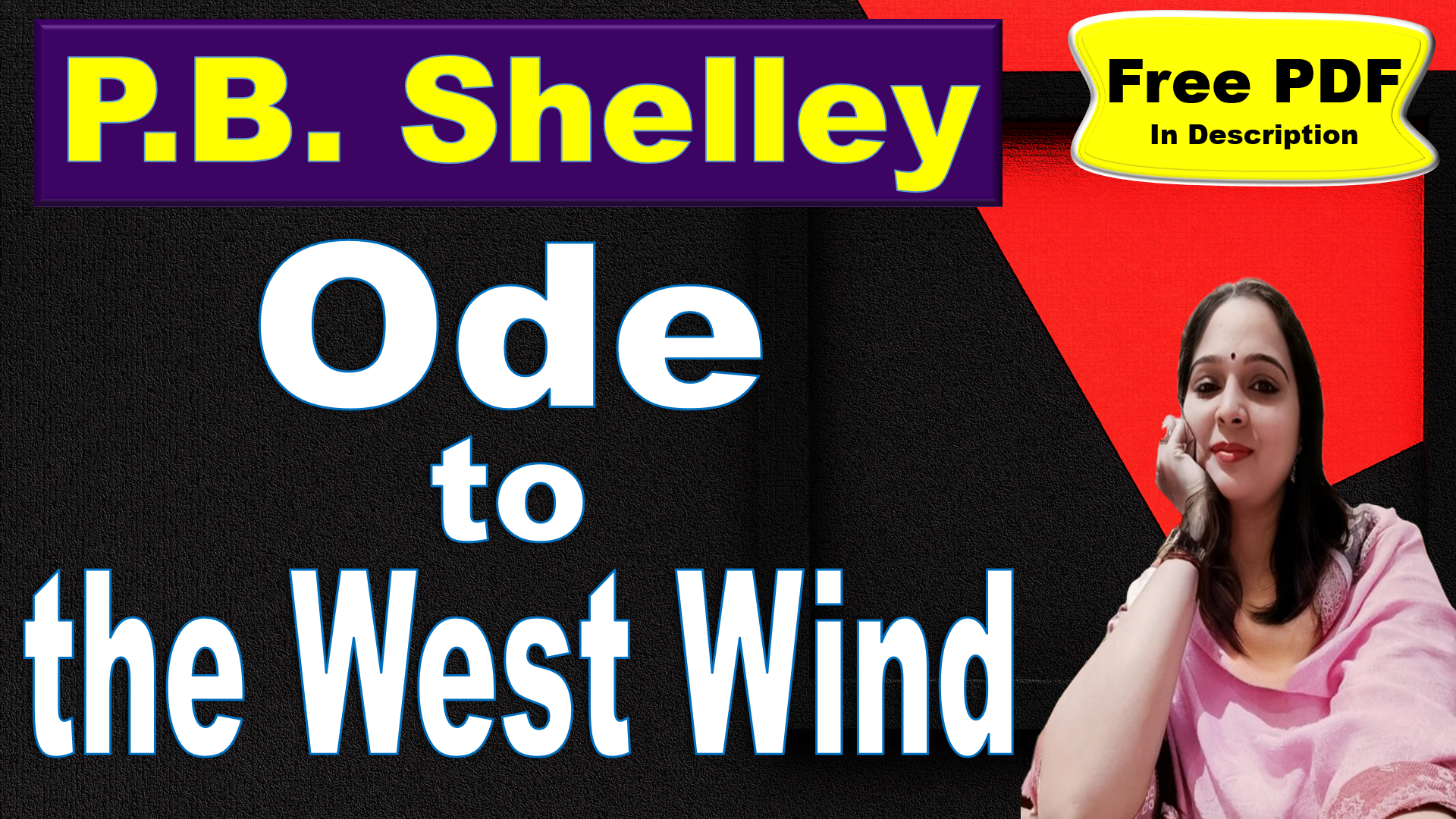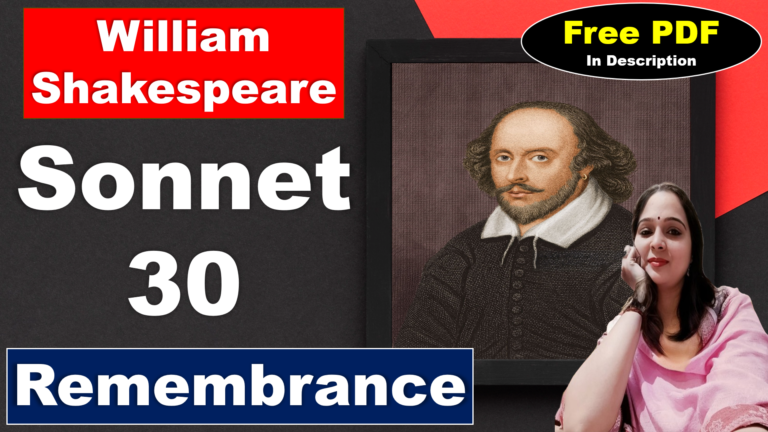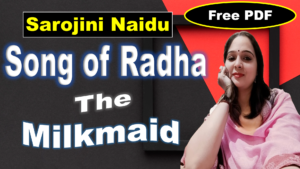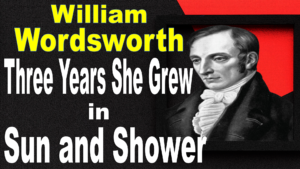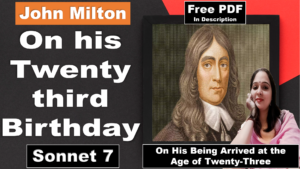Ode to the Westwind Analysis
Canto 1
O wild West Wind, thou breath of Autumn’s being,
Thou, from whose unseen presence the leaves dead
Are driven, like ghosts from an enchanter fleeing,
Yellow, and black, and pale, and hectic red,
Pestilence-stricken multitudes: O thou,
Who chariotest to their dark wintry bed
The winged seeds, where they lie cold and low,
Each like a corpse within its grave, until
Thine azure sister of the Spring shall blow
Her clarion o’er the dreaming earth, and fill
(Driving sweet buds like flocks to feed in air)
With living hues and odours plain and hill:
Wild Spirit, which art moving everywhere;
Destroyer and preserver; hear, oh hear!
Explanation: In the first canto of “Ode to the West Wind,” Percy Bysshe Shelley sets the tone for the entire poem by invoking the West Wind as a powerful and elemental force that embodies both the destructive and regenerative aspects of nature. Shelley begins by addressing the wind directly: “O wild West Wind, thou breath of Autumn’s being,” where he personifies the wind as the very “breath” or essence of autumn. This suggests that the wind is not merely a natural phenomenon but the driving force behind the season, responsible for the changes that occur as summer gives way to autumn.
The next lines, “Thou, from whose unseen presence the leaves dead / Are driven, like ghosts from an enchanter fleeing,” depict the wind as an invisible, yet omnipresent force that sweeps away the dead leaves. Shelley compares the leaves to “ghosts,” emphasizing their lifelessness, and likens the wind to an “enchanter,” a figure of supernatural power who compels the leaves to flee. This simile paints the wind as a mystical, almost otherworldly force that controls the natural world with ease.
Shelley then uses vivid and striking imagery to describe the appearance of the leaves: “Yellow, and black, and pale, and hectic red, / Pestilence-stricken multitudes.” The colors—yellow, black, pale, and “hectic red”—reflect various stages of decay, portraying the leaves as diseased and dying, reminiscent of a “pestilence-stricken” crowd. This metaphor suggests that the leaves, once vibrant and full of life, have now succumbed to the inevitable decay of autumn, becoming symbols of mortality and the passage of time.
The poem continues with the image of the West Wind as a charioteer, a figure who drives or guides something along a path: “O thou, / Who chariotest to their dark wintry bed / The winged seeds, where they lie cold and low.” Here, the wind is portrayed as a powerful force that carries “winged seeds” to their resting place in the earth, where they “lie cold and low.” These seeds, like the leaves, are in a state of dormancy, described as “Each like a corpse within its grave.” This simile emphasizes the idea of death, suggesting that the seeds are buried in the earth as if in a grave, awaiting the time when they will be resurrected.
The resurrection is anticipated in the lines that follow: “until / Thine azure sister of the Spring shall blow / Her clarion o’er the dreaming earth.” Shelley introduces the idea of Spring as the “azure sister” of the West Wind, personifying Spring as a sibling who, with her “clarion” (a trumpet-like instrument), awakens the earth from its “dreaming” or dormant state. This imagery suggests that Spring, with its bright blue skies and gentle breezes, will revive the seeds, bringing them back to life after the long winter.
Shelley continues with the image of Spring driving “sweet buds like flocks to feed in air,” comparing the new growth of plants to flocks of animals being led to pasture. The buds are “driven” by Spring, much as the leaves were driven by the West Wind, but this time the driving force is towards life and growth rather than decay and death. The earth is filled “With living hues and odours plain and hill,” indicating that Spring brings not only color (“hues”) but also fragrance (“odours”) to the landscape, rejuvenating both the plains and the hills.
In the final lines of the canto, Shelley calls the West Wind a “Wild Spirit, which art moving everywhere,” acknowledging its omnipresence and boundless energy. The wind is not confined to one place but moves freely across the earth, affecting everything in its path. Shelley also refers to the wind as both a “Destroyer and preserver,” capturing the paradoxical nature of this force. The wind destroys by scattering dead leaves and bringing decay, but it also preserves by planting seeds that will grow in the future, ensuring the cycle of life continues.
The plea “hear, oh hear!” at the end of the canto reflects Shelley’s desire to be heard by this powerful force. It conveys a sense of urgency and longing, as though the poet is seeking to connect with the wind on a deeper level, perhaps to draw upon its strength and transformative power. This invocation sets the stage for the rest of the poem, where Shelley will explore the wind’s influence not only on nature but also on his own creative spirit.
Poetic Device
Personification Shelley personifies the West Wind as a powerful, almost god-like figure with emotions and intentions. The wind is referred to as the “breath of Autumn’s being,” which gives it a life force and agency. The wind “chariotest” the seeds, acting as a charioteer, and is described as a “Destroyer and preserver.” This personification allows the wind to become a central character in the poem, embodying the themes of destruction and renewal.
Simile Similes are used to create vivid comparisons that enhance the reader’s understanding of the imagery. For example, the dead leaves are “driven, like ghosts from an enchanter fleeing.” This simile compares the leaves to ghosts being chased away by a magical force, emphasizing their lifelessness and the wind’s power over them. The phrase “like a corpse within its grave” also compares the dormant seeds to corpses, highlighting the theme of death and potential rebirth.
Metaphor Metaphors are prevalent in this canto, enriching the poem’s depth. The wind is metaphorically described as the “breath of Autumn’s being,” suggesting that the wind is the life force that drives the seasonal changes of autumn. The seeds are metaphorically referred to as “winged,” emphasizing their potential for flight and growth, even though they are currently dormant, lying “cold and low.”
Imagery Shelley uses vivid imagery to paint a picture of the autumnal landscape affected by the West Wind. The “Yellow, and black, and pale, and hectic red” leaves are described in detail, with colors that evoke the decay and death of autumn. The “winged seeds” lying “cold and low” like corpses evoke a stark image of dormancy and stillness. The “azure sister of the Spring” is a colorful and lively image that contrasts with the bleakness of autumn, suggesting the renewal that will come.
Paradox The West Wind is described as both a “Destroyer and preserver,” which is a paradox because these roles seem contradictory. However, this paradox captures the dual nature of the wind—it destroys the old and decaying (dead leaves) but also preserves life by spreading seeds that will eventually grow. This duality reflects the cyclical nature of life, death, and rebirth.
Enjambment Shelley uses enjambment, the continuation of a sentence without a pause beyond the end of a line, to create a sense of movement and flow that mirrors the wind’s continuous motion. For example, “Yellow, and black, and pale, and hectic red, / Pestilence-stricken multitudes: O thou,” continues the thought across lines, enhancing the poem’s fluidity and the sense of the wind’s unstoppable force.
Canto 2
Thou on whose stream, mid the steep sky’s commotion,
Loose clouds like earth’s decaying leaves are shed,
Shook from the tangled boughs of Heaven and Ocean,
Angels of rain and lightning: there are spread
On the blue surface of thine aëry surge,
Like the bright hair uplifted from the head
Of some fierce Maenad, even from the dim verge
Of the horizon to the zenith’s height,
The locks of the approaching storm. Thou dirge
Of the dying year, to which this closing night
Will be the dome of a vast sepulchre,
Vaulted with all thy congregated might
Of vapours, from whose solid atmosphere
Black rain, and fire, and hail will burst: oh hear!
Explanation: In the second canto of “Ode to the West Wind,” Shelley shifts his focus from the earth to the sky, describing the West Wind’s influence on the atmosphere and the dramatic changes it brings there. The wind is portrayed as a powerful force that not only stirs the earth but also has a profound effect on the heavens.
Shelley begins by addressing the wind as the force “on whose stream, mid the steep sky’s commotion,” suggesting that the wind moves like a powerful current or river through the sky, causing “commotion” or tumultuous activity. The phrase “Loose clouds like earth’s decaying leaves are shed” draws a parallel between the clouds in the sky and the dead leaves on the ground. Just as the wind scatters the leaves in the previous canto, it also dislodges and scatters the clouds, treating them as if they were the sky’s version of “decaying leaves.”
The clouds are described as being “shook from the tangled boughs of Heaven and Ocean,” which evokes an image of the clouds being forcefully shaken loose from the intertwined branches of the sky (“Heaven”) and the sea (“Ocean”). This metaphor suggests a deep connection between the elements of the sky and sea, with the wind acting as the force that disrupts and rearranges them.
Shelley then refers to the clouds as “Angels of rain and lightning,” personifying them as divine beings that carry the powerful forces of nature—rain and lightning. These clouds are seen as messengers or agents of the storm, and they are “spread / On the blue surface of thine aëry surge,” meaning they are scattered across the sky, which Shelley describes as the “blue surface” of the wind’s aerial waves or currents. The imagery here emphasizes the dynamic and fluid nature of the wind as it moves through the sky, carrying with it the potential for storms.
The comparison “Like the bright hair uplifted from the head / Of some fierce Maenad” uses a vivid simile to liken the clouds to the wild, flowing hair of a Maenad, a follower of the Greek god Dionysus known for her frenzied, ecstatic behavior. The image of the clouds being uplifted like the hair of a Maenad captures the chaotic, almost frenzied energy of the approaching storm, as the wind whips the clouds into a wild and tempestuous state.
Shelley continues with the description of the storm as it gathers strength: “even from the dim verge / Of the horizon to the zenith’s height, / The locks of the approaching storm.” Here, the “dim verge” refers to the distant edge of the horizon, and the “zenith’s height” is the highest point in the sky. The “locks of the approaching storm” are the clouds that stretch from the horizon to the zenith, indicating the vastness and all-encompassing nature of the storm that the wind is bringing.
The wind is then called the “dirge / Of the dying year,” where a dirge is a mournful song or lament, typically associated with death. Shelley personifies the wind as singing a dirge for the “dying year,” symbolizing the end of the annual cycle and the approach of winter. The “closing night” of the year will be “the dome of a vast sepulchre,” suggesting that the night sky, filled with storm clouds, will become the roof of a gigantic tomb where the year is metaphorically buried.
Shelley further emphasizes the power and ominous nature of the storm by describing the sky as “vaulted with all thy congregated might / Of vapours,” indicating that the storm clouds have gathered together in a massive, imposing formation. From this “solid atmosphere” of clouds, “Black rain, and fire, and hail will burst,” predicting a fierce and destructive storm. The combination of rain, lightning (“fire”), and hail underscores the full destructive potential of the West Wind’s storm, as it unleashes its fury upon the earth.
The canto ends with the repeated plea “oh hear!” echoing the conclusion of the first canto. This plea underscores Shelley’s deep desire to connect with the wind, to be heard by this powerful force of nature, and perhaps to draw inspiration from its energy and transformative power. The second canto builds on the themes introduced in the first, expanding the scope of the wind’s influence from the earth to the sky and portraying it as an even more formidable force that heralds the end of the year and the coming of winter.
Poetic Device
Personification The West Wind is personified throughout the canto as a powerful and almost divine force. The wind is depicted as having control over the clouds, “shook from the tangled boughs of Heaven and Ocean.” By attributing human-like actions to the wind, Shelley emphasizes its dynamic presence and influence. The clouds are referred to as “Angels of rain and lightning,” personifying them as celestial beings that bring about storms, further highlighting the divine or supernatural power of the wind.
Simile Shelley employs similes to create vivid comparisons that enhance the imagery of the poem. The clouds are compared to “earth’s decaying leaves” as they are “shed” from the sky, likening their movement to the way dead leaves are scattered by the wind in autumn. Another powerful simile is used when Shelley compares the clouds to “the bright hair uplifted from the head / Of some fierce Maenad.” The Maenads were frenzied followers of Dionysus in Greek mythology, known for their wild, untamed behavior. This comparison suggests the wild and chaotic nature of the storm clouds being driven by the wind, as they resemble the disheveled hair of a frenzied woman.
Metaphor Metaphors are used to deepen the meaning of the imagery. For instance, Shelley refers to the West Wind’s movement as a “stream” in the sky, implying that the wind flows like a river, creating “steep sky’s commotion.” The clouds are described as being “shook from the tangled boughs of Heaven and Ocean,” which is a metaphorical image suggesting that the sky and sea are interconnected, with the wind acting as a force that untangles and disrupts them. Additionally, the wind is metaphorically called a “dirge of the dying year,” with a dirge being a mournful song, which captures the wind’s role in marking the end of the year, ushering in the death of the old and the approach of winter.
Imagery Shelley’s use of imagery in this canto is particularly vivid and dynamic. The “loose clouds” are depicted as being shaken from the “tangled boughs of Heaven and Ocean,” creating a picture of the sky and sea being violently disturbed. The “blue surface of thine aëry surge” refers to the sky being swept by the wind, with clouds spread across it like waves on the ocean. The image of “the bright hair uplifted from the head / Of some fierce Maenad” adds to the wild and intense atmosphere, with the clouds taking on the appearance of disheveled hair in the midst of a storm.
Alliteration Alliteration is used to create a musical quality and to emphasize certain aspects of the imagery. For example, the phrase “steep sky’s commotion” uses the repetition of the “s” sound, which mimics the sound of the wind and enhances the sense of turbulence in the sky.
Enjambment Shelley uses enjambment to create a sense of continuous movement, reflecting the unceasing flow of the wind. For instance, the lines “Loose clouds like earth’s decaying leaves are shed, / Shook from the tangled boughs of Heaven and Ocean,” flow into each other without a pause, mirroring the relentless motion of the wind and the storm it carries.
Canto 3
Thou who didst waken from his summer dreams
The blue Mediterranean, where he lay,
Lull’d by the coil of his crystalline streams,
Beside a pumice isle in Baiae’s bay,
And saw in sleep old palaces and towers
Quivering within the wave’s intenser day,
All overgrown with azure moss and flowers
So sweet, the sense faints picturing them! Thou
For whose path the Atlantic’s level powers
Cleave themselves into chasms, while far below
The sea-blooms and the oozy woods which wear
The sapless foliage of the ocean, know
Thy voice, and suddenly grow gray with fear,
And tremble and despoil themselves: oh hear!
Explanation: In the third canto of “Ode to the West Wind,” Shelley shifts his focus from the sky to the sea, exploring the West Wind’s influence on the Mediterranean and the Atlantic Oceans. The imagery in this section is rich with descriptions of the wind’s power to disturb even the most tranquil and ancient of landscapes, emphasizing its role as a force of change and renewal.
Shelley begins by addressing the wind as the one “who didst waken from his summer dreams / The blue Mediterranean.” The Mediterranean Sea is personified as being in a state of peaceful slumber during the summer, lulled by the gentle “coil of his crystalline streams.” These streams refer to the calm, clear waters of the Mediterranean, which flow smoothly and serenely during the warm months.
The scene is set beside a “pumice isle in Baiae’s bay,” a reference to the ancient Roman resort town of Baiae, known for its volcanic islands and luxurious villas. The mention of “old palaces and towers” evokes a sense of ancient grandeur and history, with these structures “quivering within the wave’s intenser day.” This phrase suggests that the ruins of these once-magnificent buildings can be seen shimmering and trembling under the bright sunlight, as they are partially submerged in the water. The image of the palaces and towers quivering within the waves creates a dreamlike and nostalgic atmosphere, as if the remnants of the past are barely holding on, on the verge of being lost forever.
These ancient structures are described as being “all overgrown with azure moss and flowers / So sweet, the sense faints picturing them!” The “azure moss and flowers” that cover the ruins add to the ethereal beauty of the scene, with their colors and scents being so overwhelming that they almost cause the senses to faint. This description underscores the richness and fertility of the natural world, even in the midst of decay and abandonment.
Shelley then contrasts the calm Mediterranean with the more powerful and tumultuous Atlantic Ocean: “Thou / For whose path the Atlantic’s level powers / Cleave themselves into chasms.” The West Wind is so strong that the “level powers” of the Atlantic—its vast, flat surface—are split apart into “chasm,” or deep fissures in the water. This imagery conveys the immense power of the wind, capable of creating dramatic and violent changes in the ocean’s surface.
The wind’s impact extends deep beneath the ocean’s surface, where “sea-blooms and the oozy woods which wear / The sapless foliage of the ocean” reside. These “sea-blooms” and “oozy woods” refer to the marine vegetation that grows in the depths of the ocean, which are described as having “sapless foliage,” indicating that they are lifeless or decayed. Despite being so far below, even these deep-sea plants “know / Thy voice,” meaning they can sense the presence of the wind and are affected by it.
The response of these underwater plants to the wind is one of fear and submission: “and suddenly grow gray with fear, / And tremble and despoil themselves.” The plants, though typically unaffected by surface conditions, are so overwhelmed by the power of the wind that they lose their color (“grow gray with fear”) and shed their leaves or parts (“despoil themselves”). This imagery reinforces the idea that the West Wind is a force that can reach into every corner of the natural world, instilling fear and causing change even in the deepest, most hidden places.
The canto concludes, as the previous ones do, with the repeated plea “oh hear!” This plea emphasizes Shelley’s desire to be heard and understood by the powerful force he is invoking. Throughout this canto, the West Wind is portrayed as a mighty and transformative force, capable of awakening the sleeping Mediterranean, disrupting the powerful Atlantic, and even influencing the hidden depths of the ocean. This continues the poem’s exploration of the wind’s dual nature as both a destroyer and a preserver, as well as its role in the natural cycle of death, decay, and renewal.
Poetic Device
Personification The Mediterranean Sea is personified as a being that can “dream” and be “lull’d” to sleep by its own “crystalline streams.” This personification creates an image of the sea as a living entity, capable of experiencing a peaceful, almost human-like state of rest during the summer. The West Wind is the force that “didst waken” the Mediterranean from this slumber, disrupting its tranquility. This personification underscores the wind’s power to alter even the calmest of natural environments.
Imagery Shelley uses rich and detailed imagery to describe the Mediterranean and its surroundings. The sea is depicted as “blue,” lying beside “a pumice isle in Baiae’s bay,” which evokes a sense of ancient beauty and tranquility. The imagery of “old palaces and towers / Quivering within the wave’s intenser day” captures the reflection of these ancient structures in the water, trembling under the bright sunlight, as if the past is fragile and fleeting. The “azure moss and flowers” that overgrow these ruins are described as so beautiful that “the sense faints picturing them,” highlighting the overwhelming richness of the scene.
Alliteration Alliteration is used subtly to create a musical quality within the lines. For example, “Beside a pumice isle in Baiae’s bay” uses the repetition of the “b” sound, which adds to the rhythm and flow of the verse, enhancing the serene and dreamlike atmosphere of the Mediterranean before it is disturbed by the wind.
Metaphor Shelley uses metaphor to describe the wind’s effect on the ocean. The “Atlantic’s level powers / Cleave themselves into chasms” is a metaphor that suggests the wind is so powerful that it can split the ocean’s surface into deep fissures or chasms. This image conveys the immense strength of the wind, capable of creating dramatic changes in the landscape. Additionally, the “sapless foliage of the ocean” is a metaphor for the lifeless or decayed marine vegetation that lies deep below the ocean’s surface, which is still affected by the wind’s voice.
Symbolism The seas themselves are symbolic of ancient, enduring natural forces. The Mediterranean, with its “old palaces and towers,” represents history and tradition, while the Atlantic, with its vast, level expanse, symbolizes the raw, untamed power of nature. The West Wind, by disturbing these seas, symbolizes the force of change, which can disrupt even the most stable and ancient of things.
Enjambment Shelley uses enjambment to create a sense of fluidity and motion, reflecting the continuous movement of the wind and the sea. For instance, the line “Thou who didst waken from his summer dreams / The blue Mediterranean, where he lay,” flows smoothly into the next, mimicking the seamless and unstoppable flow of the wind across the sea.
Canto 4
If I were a dead leaf thou mightest bear;
If I were a swift cloud to fly with thee;
A wave to pant beneath thy power, and share
The impulse of thy strength, only less free
Than thou, O uncontrollable! If even
I were as in my boyhood, and could be
The comrade of thy wanderings over Heaven,
As then, when to outstrip thy skiey speed
Scarce seem’d a vision; I would ne’er have striven
As thus with thee in prayer in my sore need.
Oh, lift me as a wave, a leaf, a cloud!
I fall upon the thorns of life! I bleed!
A heavy weight of hours has chain’d and bow’d
One too like thee: tameless, and swift, and proud.
Explanation: In the fourth canto of “Ode to the West Wind,” Shelley shifts from describing the West Wind’s effects on nature to a more personal reflection, expressing a deep yearning to be united with the wind and share in its freedom and power. The tone becomes introspective as Shelley explores his desire to escape the burdens of life and recapture the vitality of his youth.
The canto begins with a series of conditional statements: “If I were a dead leaf thou mightest bear; / If I were a swift cloud to fly with thee; / A wave to pant beneath thy power, and share / The impulse of thy strength, only less free / Than thou, O uncontrollable!” Here, Shelley imagines himself as different elements—dead leaves, clouds, and waves—that are all influenced and driven by the West Wind. He longs to be as free and powerful as these natural elements, swept along by the wind’s force. The repetition of “If I were” emphasizes his wish to be one with the wind, to be carried away by it and to experience the same boundless freedom.
Shelley acknowledges the wind as “O uncontrollable!”—a force of nature that is wild and untamed, something he admires and wishes to emulate. He reflects on his youth, when he felt more connected to the wind’s energy: “If even / I were as in my boyhood, and could be / The comrade of thy wanderings over Heaven.” In these lines, Shelley nostalgically recalls a time when he felt as if he could keep up with the wind, as though he were its “comrade” or companion, able to share in its “wanderings over Heaven.”
He remembers when the idea of outpacing the wind’s “skiey speed” “scarce seemed a vision,” meaning it was almost within reach. This memory contrasts sharply with his current state, where he finds himself “striven” and in “sore need,” far removed from the vitality and freedom he once felt. The longing for his lost youth and energy is palpable here, as he wishes to return to a time when he felt unburdened and full of life.
Shelley then makes a desperate plea to the wind: “Oh, lift me as a wave, a leaf, a cloud!” He asks the wind to elevate him, to carry him away from his current suffering, much like it lifts and moves the natural elements he described earlier. He continues with the powerful metaphor, “I fall upon the thorns of life! I bleed!” Here, Shelley conveys his deep pain and despair, comparing his suffering to falling onto thorns, a vivid image of physical and emotional agony.
The final lines express a profound identification with the wind: “A heavy weight of hours has chain’d and bow’d / One too like thee: tameless, and swift, and proud.” Shelley laments that the passage of time (“a heavy weight of hours”) has “chain’d and bow’d” him, weighing him down and robbing him of the qualities he once shared with the wind—being “tameless, and swift, and proud.” This suggests that, like the wind, Shelley was once free-spirited, energetic, and defiant, but life’s struggles have subdued him.
In this canto, Shelley’s deep yearning to escape the burdens of life and reconnect with the wild, untamed energy of the West Wind is poignantly expressed. The wind symbolizes the freedom and power that Shelley longs to regain, and his plea to be lifted by the wind reflects his desire to overcome the suffering and limitations that have constrained him.
Poetic Device
Anaphora Shelley employs anaphora, the repetition of a phrase at the beginning of successive lines, to emphasize his wish to be one with the elements driven by the wind. The lines “If I were a dead leaf thou mightest bear; / If I were a swift cloud to fly with thee; / A wave to pant beneath thy power” all begin with “If I were,” highlighting his deep desire to be carried by the wind, whether as a leaf, a cloud, or a wave. This repetition creates a rhythmic longing, drawing the reader into the poet’s wish to be part of the natural world.
Personification Shelley continues to personify the West Wind as a powerful and almost divine force. The wind is described as “O uncontrollable,” emphasizing its wild and untamed nature. This personification underscores the wind’s freedom and strength, qualities that Shelley admires and wishes to embody. The poet also personifies himself, imagining himself as a “comrade” of the wind, capable of joining it in its “wanderings over Heaven.”
Simile Similes are used to draw comparisons between the poet’s desire and natural elements. For example, Shelley wishes the wind to “lift me as a wave, a leaf, a cloud!” By comparing himself to these elements, he expresses his desire to be as free and unbound as they are when carried by the wind. The simile “I fall upon the thorns of life! I bleed!” compares his suffering to being physically wounded by thorns, conveying the pain and anguish he feels in his current state.
Metaphor The metaphor “A heavy weight of hours has chain’d and bow’d / One too like thee” describes time as a burden that has weighed him down and subdued his once free and untamed spirit. Here, Shelley compares himself to the West Wind, indicating that he once shared its qualities of being “tameless, and swift, and proud.” However, the passage of time has “chain’d and bow’d” him, restricting his freedom and vitality.
Imagery The imagery in this canto is particularly vivid, capturing the dynamic relationship between the poet and the wind. Shelley imagines himself as a “dead leaf,” a “swift cloud,” and a “wave,” all of which are driven by the wind. These images evoke the natural elements in motion, emphasizing the poet’s longing to be part of this movement. The imagery of “fall[ing] upon the thorns of life” conjures a stark picture of suffering and vulnerability, highlighting the contrast between his current state and the freedom he desires.
Paradox The paradox “only less free / Than thou, O uncontrollable!” reflects the poet’s recognition that even if he were a leaf, cloud, or wave, he would still be “less free” than the wind itself. This acknowledges the ultimate untamed and unconstrained nature of the wind, which is free in a way that no other natural element can be.
Enjambment Shelley uses enjambment to create a sense of continuous movement, reflecting the flow of the wind. Lines like “As then, when to outstrip thy skiey speed / Scarce seem’d a vision; I would ne’er have striven” run over into the next line without a pause, mimicking the relentless and unstoppable nature of the wind and the poet’s thoughts.
Hyperbole The phrase “A heavy weight of hours has chain’d and bow’d / One too like thee” is an example of hyperbole, where the burden of time is exaggerated to convey the immense impact it has had on the poet. This hyperbole emphasizes the dramatic change from his former state of being “tameless, and swift, and proud” to his current state of being weighed down and restricted by time and experience.
Canto 5
Make me thy lyre, even as the forest is:
What if my leaves are falling like its own!
The tumult of thy mighty harmonies
Will take from both a deep, autumnal tone,
Sweet though in sadness. Be thou, Spirit fierce,
My spirit! Be thou me, impetuous one!
Drive my dead thoughts over the universe
Like wither’d leaves to quicken a new birth!
And, by the incantation of this verse,
Scatter, as from an unextinguish’d hearth
Ashes and sparks, my words among mankind!
Be through my lips to unawaken’d earth
The trumpet of a prophecy! O Wind,
If Winter comes, can Spring be far behind?
Explanation: In the fifth and final canto of “Ode to the West Wind,” Shelley moves from a personal plea to a broader, almost prophetic vision. The poet asks the West Wind not just to carry him away but to make him an instrument of change, channeling its immense power and energy through him to inspire renewal and transformation in the world.
The canto begins with a powerful metaphor: “Make me thy lyre, even as the forest is.” Shelley asks the wind to use him as it does the forest, where the trees, like the strings of a lyre (a stringed musical instrument), produce music when the wind blows through them. He recognizes that, like the trees losing their leaves in autumn, he too is experiencing decline (“What if my leaves are falling like its own!”). Despite this, he believes that the wind’s “tumult of thy mighty harmonies” will create a “deep, autumnal tone” from both the forest and himself—a tone that, while tinged with sadness, is still sweet and beautiful. This suggests that there is beauty and value in the melancholy of autumn, and by extension, in his own struggles and decline.
Shelley then makes a direct and passionate appeal to the wind: “Be thou, Spirit fierce, / My spirit! Be thou me, impetuous one!” Here, he asks the wind to embody his spirit, or rather, for his spirit to become as fierce and impetuous as the wind itself. He desires to be filled with the same wild, uncontrollable energy that the wind possesses, so that he can become a force for change and renewal.
The poet goes on to ask the wind to “Drive my dead thoughts over the universe / Like wither’d leaves to quicken a new birth!” This is a powerful image where Shelley likens his stagnant or “dead” thoughts to the withered leaves the wind scatters in autumn. He wants the wind to carry these thoughts across the world, to spread them far and wide, so that they can inspire new ideas and renewal, much like the leaves that decay and fertilize the earth, allowing for new growth in the spring.
Shelley continues this idea with “And, by the incantation of this verse, / Scatter, as from an unextinguish’d hearth / Ashes and sparks, my words among mankind!” He views his poem as a kind of magical spell or “incantation” that, with the wind’s help, will scatter his words like “ashes and sparks” from a hearth that is still alive with heat and potential. These words, carried by the wind, will spread among humanity, igniting new thoughts and actions. The image of “ashes and sparks” suggests both the remnants of something that has burned (perhaps his past thoughts or efforts) and the potential for new fires to be kindled, symbolizing the idea of rebirth and inspiration.
Shelley then asks the wind to “Be through my lips to unawaken’d earth / The trumpet of a prophecy!” He wants to become the mouthpiece of the wind, delivering a message to the world, much like a trumpet blast that announces something important. The “unawaken’d earth” refers to humanity, which is seen as dormant or unaware, needing to be awakened to new possibilities and ideas. Shelley envisions his words, carried by the wind, as a prophetic message that will stir the world into action and awareness.
The canto, and the poem, concludes with one of Shelley’s most famous lines: “O Wind, / If Winter comes, can Spring be far behind?” This line encapsulates the central theme of the poem—the cycle of destruction and renewal. While winter brings death and decay, it is always followed by spring, which brings new life and growth. Shelley expresses hope and optimism that even in the darkest times, renewal and rebirth are inevitable. This final line is a powerful reminder that no matter how bleak things may seem, there is always the promise of renewal and new beginnings.
In this canto, Shelley synthesizes the themes of the entire poem, blending his personal longing with a broader vision for humanity. He wants the West Wind to inspire not only his own transformation but also to spread that transformation to the world, bringing about a new era of creativity, growth, and change.
Poetic Device
Metaphor The metaphor of the poet as a “lyre” played by the wind is central to this canto. Shelley asks the wind to “Make me thy lyre, even as the forest is,” comparing himself to a musical instrument that the wind can play, just as it plays the forest’s trees. This metaphor suggests that Shelley wants to be an instrument through which the wind’s power—symbolizing inspiration and creativity—can manifest. The “leaves” falling from the poet, like those from the trees, represent his thoughts or perhaps his poetic works that are in decline or decay, but which the wind can transform into something new and powerful.
Personification The West Wind is again personified as a powerful, almost divine force that can inspire and rejuvenate. Shelley calls the wind “Spirit fierce,” and implores it to become his own spirit, to merge with him (“Be thou me, impetuous one!”). This personification emphasizes the wind’s role as a creative and transformative force, capable of revitalizing not just nature, but also the poet’s thoughts and spirit.
Imagery Vivid imagery continues to play a crucial role in conveying the poem’s themes. Shelley describes the wind’s music as having a “deep, autumnal tone,” which suggests a sound that is both rich and tinged with sadness, reflecting the melancholy of autumn. The image of “wither’d leaves” being driven over the universe by the wind symbolizes the spread of the poet’s “dead thoughts,” which, though lifeless now, have the potential to bring about “a new birth” when scattered by the wind. The image of “ashes and sparks” scattered “as from an unextinguish’d hearth” further reinforces the idea of potential renewal—just as a fire can be rekindled from embers, so too can the poet’s words ignite new ideas and actions among humanity.
Simile Shelley uses similes to draw powerful comparisons that enhance the reader’s understanding of his intentions. For example, he asks the wind to “Drive my dead thoughts over the universe / Like wither’d leaves to quicken a new birth!” Here, his thoughts are compared to “wither’d leaves” that, although seemingly dead, can lead to new growth when carried and scattered by the wind. This simile underscores the theme of renewal and the cyclical nature of life, death, and rebirth.
Enjambment Enjambment is used throughout the canto to maintain the flow and momentum of the verse, reflecting the continuous and unstoppable force of the wind. For example, the lines “Drive my dead thoughts over the universe / Like wither’d leaves to quicken a new birth!” flow into each other without pause, mirroring the way the wind carries leaves and seeds without interruption.
Paradox The idea of “dead thoughts” being driven to “quicken a new birth” is a paradox that encapsulates the theme of renewal through destruction. Although the thoughts are “dead,” they hold the potential for new life when scattered by the wind. This paradox highlights the poem’s central theme: that destruction and creation are interconnected, and that out of decay and death can come new life and growth.
Repetition Shelley uses repetition for emphasis, particularly in the plea “Be thou, Spirit fierce, / My spirit! Be thou me, impetuous one!” The repeated call for the wind to become his spirit underscores his desperate desire for transformation and renewal, as well as his wish to be as free, powerful, and untamed as the wind itself.
Rhetorical Question The final line, “If Winter comes, can Spring be far behind?” is a rhetorical question that serves as both a conclusion and a reminder of the inevitable cycle of seasons. This question reinforces the poem’s theme of hope and renewal, suggesting that after the darkness and death of winter, spring and rebirth are certain to follow.

